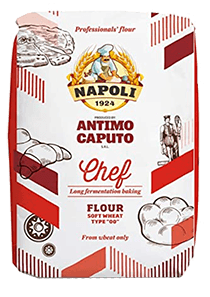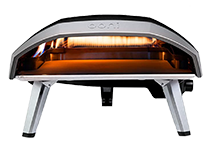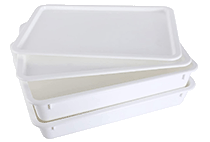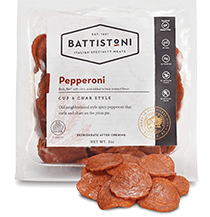Everybody has an opinion on pizza crust. Some like it thick like a Chicago-style deep dish, others prefer a crunchy cracker-like crust like a St. Louis-style pizza, and others prefer somewhere in between with a crispy bite and chewy middle. In our opinion, they are all great.
Table of Contents
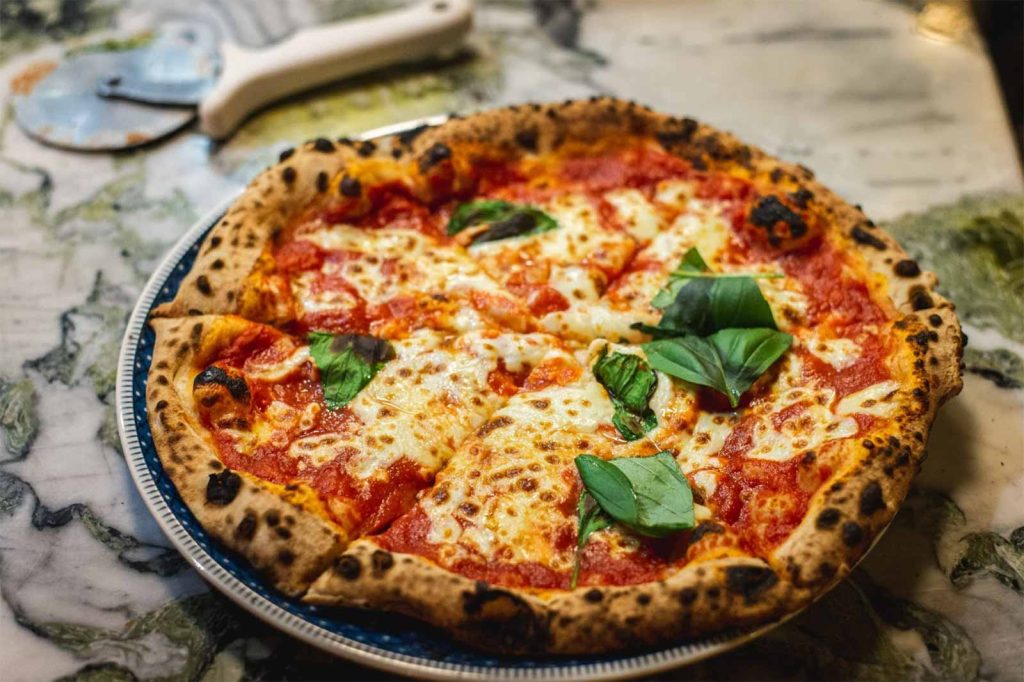
But one thing that stands out in a cooked crust is the char. The charred black spots on a pizza crust are not a mistake, and these intentionally black spots are called leopard pizza crust and are most common on a Neapolitan pizza.
What is Leopard a Pizza Crust?
Leopard pizza crust is the burnt black spots sometimes referred to as char on a Neapolitan pizza. They are a result of pizza dough with high hydration cooked at very high heat. Hydration in pizza dough refers to a dough with a high percentage of water in it.
For example, pizza dough with 1000 grams of flour and 700 grams of water has 70% hydration. The best flour to use that can handle the level of hydration is a high gluten flour like a 00 flour. When you throw that pizza dough in an extremely hot pizza oven, one that gets to a temperature above 800° degrees F, you will get these black leopard spots.
A true Neapolitan pizza has a thin crust with leopard spots. The crust is light and airy in the middle giving it the perfect chewy texture. Neapolitan pizza keeps the toppings simple with an uncooked tomato sauce and fresh mozzarella, and is then baked in a wood-fired oven.
Many pizzaiolos swear that without a leopard pizza crust, it isn’t a true Neapolitan pizza. The belief is firm, and there is even a Neapolitan Pizza Association (Associazione Verace Pizza Napoletana, AVPN), a non-profit organization and was founded in June 1984 in Naples that certifies Neapolitan pizzerias around the globe and keeps this UNESCO-protected art form authentic.
That said, any pizza can have a leopard pizza crust with a high-quality brick pizza oven. In the U.S., we believe in innovation and creativity, so as long as you follow the two rules of leoparding; with a hydrated dough and a hot oven, you can leopard any pizza you like.
So while there are rules for Neapolitan pizza, which we respect, it’s perfectly fine to borrow techniques in the name of making great pizza, whether it’s traditional or not.
Why You Should Leopard a Pizza Crust
The main reason that leopard pizza crust is done is to add another dimension of flavor. These black spots add a smoky, rich flavor and texture that contrast the creaminess of melted cheese and sweet marinara. It’s this complex contrast of flavors that makes a leopard pizza crust so desirable.
Don’t mistake these black spots for a burnt crust; a burnt crust is bitter and leaves a charcoal taste in your mouth. Instead, these spots are spaced out and cover the crust but not the bottom crust of the pizza.
Many home pizzaiolos practice leoparding; it takes real skill to make a hydrated dough and to get the temperature and timing just right. If you wait too long, you have burnt pizza. If you remove it too soon, you have a doughy mess.
It takes skilled pizzaiolos time to master this skill. If you want to learn from the experts, you can train to be a pizzaiolo and get certified or take an online class from an expert like Vito Iacopelli.
While the best way to leopard a pizza requires you have a pizza oven at home, it’s not an option for everyone. Luckily, there is a way to get a leopard crust at home with a regular convection oven.
How To Leopard a Pizza Crust at Home
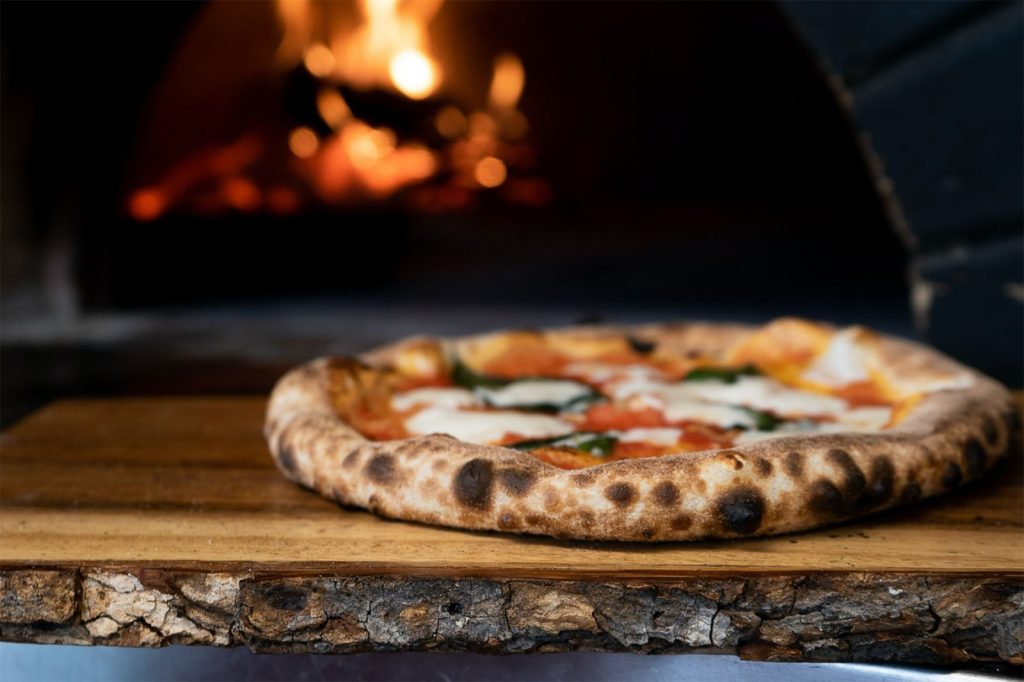
Ok, first, you need to have a well-hydrated dough, so here is a recipe that we like to use:
- 2 ¾ cup 00 flour
- ¾ cup lukewarm water 105-110 degrees F
- 1/2 tablespoon salt
- ¾ teaspoon active dry yeast
- ¼ cup extra virgin olive oil
- 1 tablespoon of honey
Start by proofing the yeast; mix the yeast, water, and honey and set aside for around 10 minutes. Then in another bowl, mix the dry ingredients together. When the yeast is activated, slowly start to mix the yeast into the dough.
Mix in half of the yeast, then add in some in olive oil. Then mix in the rest of the yeast. The dough is going to be a wet sticky ball of goo, that’s a good thing. Then cover and let it rest for 15 minutes.
Next, use a silicone spatula and mix it around a few more times. Cover the dough and let it rise until double in size, usually around 2-3 hours. Then, divide the dough into separate dough balls.
This recipe makes two 12-inch pizzas or several smaller ones. Lightly flour each dough ball and let rest for another hour. Then you are ready with a well-hydrated dough.
Make Leopard Crust with Convection Oven
Using a regular home oven to make that leopard crust is a play between using a hot oven and the broil setting. Ideally, you want the pizza to cook from the top and the bottom. The best way to do this is to use a pizza stone because they hold the heat.
Preheat your oven to the highest setting, which is usually 550º F. Always heat your stone first. Then, when you put your pizza in, turn down the oven to 400º F while turning on the broil. Also, raise your oven racks, so the pizza is close to the broiler.
This whole process will be fairly quick, and since every home oven is slightly different, for example, some broilers will turn off, so you might have to keep turning it on. You may have to play with this a bit the first time you try leoparding the crust. But trust us, it will work, and you will get a crispy charred leopard crust with an airy, chewy texture.
Pro Tips for Getting Leopard Pizza Crust At Home
- If the dough is pale with spots, then the dough was too cold.
- Use 00 flour because it has higher gluten and leopards easier.
- Add honey instead of sugar to proof yeast because it feeds the yeast and causes caramelization of the sugars.
What do you think of leopard pizza crust? Have you tried this convection oven/broiler method? You might also be interested in ways to keep your pizza warm after you’ve achieved that beautiful char.

